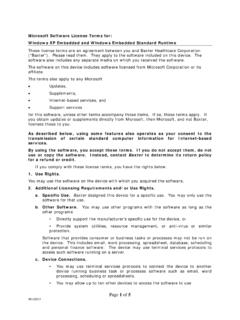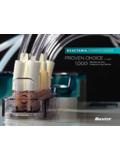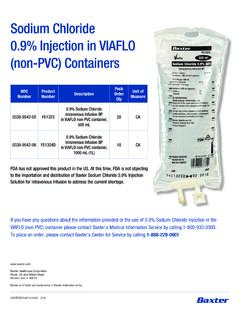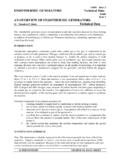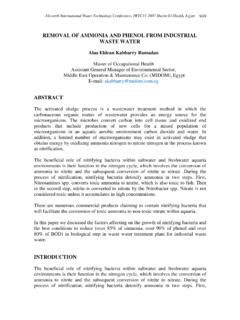Transcription of promote positive nitrogen balance. Solution ...
1 Confidential Property of Baxter Healthcare Corporation and its Affiliates * This artwork requires that the supplier insert a code 39 bar code master in the position indicated. Bar code must match human readable on art and on spec. Bar code must conform to all applicable Baxter specifications. Document No.: 07-19-57-385. Change No.: CP0329253. PROOFREADING INSPECTION / RELEASED ARTWORK. Page 1 of 2 Proofreading Approval _____ _____ _____. Print Name Signature Date P1 16 Sep 2010 sbh Proofreading Approval _____ _____ _____. Print Name Signature Date Pediatric Use: Use of clinimix E sulfite-free (Amino Acid with Electrolytes in Dextrose clinimix E Injection solutions containing additives should be used promptly after 07-19-57-385. with Calcium) Injections in pediatric patients is governed by the same considerations that admixture. Any storage should be under refrigeration and limited to a brief period affect the use of any amino acid Solution in pediatrics.
2 The amount administered is dosed of time, less than 24 hours. on the basis of grams of amino acids/kg of body weight/day. Two to 3 g/kg of body weight for infants with adequate calories are generally sufficient to satisfy protein needs and To add Fat Emulsion for 3-in-1 admixture: E. promote positive nitrogen balance . Solution administrations by peripheral vein should See Warnings section regarding incompatible additives including fat emulsions. not exceed twice normal serum osmolarity (718 mOsmol/L). Central Vein Administration: Hypertonic mixtures of amino acid with electrolytes/dextrose 1. Prior to adding fat emulsion, mix amino acid and dextrose injection as shown in Figure 2. 2. Prepare fat emulsion transfer set following instructions provided. clinimix E sulfite-free with calcium injections may be administered safely by continuous infusion through a central vein catheter with the tip located in the vena cava.
3 In addition to meeting nitrogen needs, the administration rate is governed, especially during the first few days of therapy, by the patient's tolerance to dextrose, as indicated by frequent determinations of urine 3. Attach transfer set to fat emulsion bottle using aseptic technique. 4. Twist off protector on the additive port of the CLARITY container. (Amino Acid with Electrolytes in Dextrose with Calcium) Injections 5. Attach the transfer set to the exposed additive port. and blood sugar levels. Daily intake of amino acid with electrolytes/dextrose with calcium injections should be increased gradually to the maximum required dose. 6. Open clamp on transfer set. in CLARITY Dual Chamber Container 7. After completing transfer, use appropriate plastic clamp or metal ferrule Sudden cessation in administration of these admixed injections may result in insulin to seal off additive port tube.
4 Reaction due to continued endogenous insulin production. Parenteral nutrition mixtures should be withdrawn slowly. 8. Remove transfer set. Description in serum amino acid imbalances, hyperammonemia, stupor, and coma. 9. Mix contents of CLARITY container thoroughly. Check for leaks. clinimix E sulfite-free (Amino Acid with Electrolytes in Dextrose with Calcium) Injections Hyperammonemia is of special significance in infants. This reaction appears to Peripheral Vein Administration: For patients requiring parenteral nutrition in whom the be related to a deficiency of the urea cycle amino acids of genetic or product origin. central vein route is not indicated, low concentration amino acid with electrolytes/dextrose Storage: Storage of the 3-in-1 admixture must be under refrigeration and limited are sterile, nonpyrogenic, hypertonic solutions in a CLARITY Dual Chamber Container. It is essential that blood ammonia be measured frequently in infants.
5 With calcium injections may be administered by peripheral vein. In pediatric patients, to a brief period of time, no longer than 24 hours. See Warnings section regarding The sulfite-free Amino Acid Injections with Electrolytes in the outlet port chamber the final Solution should not exceed twice normal serum osmolarity (718 mOsmol/L). incompatible additives. are solutions of essential and nonessential amino acids provided with electrolytes. Conservative doses of these admixed amino acid with electrolytes/dextrose with calcium injections should be given to patients with known or suspected hepatic dysfunction. To Add Medication The Dextrose Injections with Calcium in the injection port chamber are solutions for fluid Should symptoms of hyperammonemia develop, administration should be discontinued Directions for Use of Plastic Container replenishment and caloric supply. WARNING: Additives may be incompatible.
6 And the patient's clinical status be reevaluated. WARNING: Do not use plastic containers in series connections. Such use could After opening the seal between the chambers and mixing thoroughly, the admixed product result in air embolism due to residual air being drawn from the primary container Supplemental medication may be added with a 19 to 22 gauge needle through the Administration of amino acid solutions in the presence of impaired renal function presents is intended for intravenous use. See Table 1 for composition, pH, osmolarity, ionic special issues associated with retention of electrolytes. before administration of the fluid from the secondary container is completed. medication port. concentration and caloric content of the admixed product. BE SURE THE CONTENTS OF BOTH CHAMBERS ARE MIXED TOGETHER AFTER OPENING 1. Prepare medication port. These admixed injections should not be administered simultaneously with blood through The CLARITY Dual Chamber Container is a lipid-compatible plastic container the same infusion set because of the possibility of pseudoagglutination.
7 SEAL BETWEEN CHAMBERS. After opening seal between chambers, lipids and/or 2. Using syringe with 19 to 22 gauge needle, puncture resealable medication port (PL 2401 Plastic). The amount of water that can permeate from inside the container additives can be introduced to the container. Thorough mixing ensures complete and inject. into the overwrap is insufficient to affect the Solution significantly. solutions in contact In very low birth weight infants, excessive or rapid administration of dextrose injection delivery of all ingredients. 3. Mix Solution and medication thoroughly. For high density medication, such as with the plastic container may leach out certain chemical components from the plastic may result in increased serum osmolality and possible intracerebral hemorrhage. potassium chloride, squeeze ports while ports are upright and mix thoroughly. in very small amounts; however, biological testing was supportive of the safety of the WARNING: This product contains aluminum that may be toxic.
8 Aluminum may reach To Open 4. Check for leaks. plastic container materials. toxic levels with prolonged parenteral administration if kidney function is impaired. Tear overwrap across top at slit and remove Solution container. Some opacity of the Premature neonates are particularly at risk because their kidneys are immature, and plastic due to moisture absorption during the sterilization process may be observed. Preparation for Administration Clinical Pharmacology they require large amounts of calcium and phosphate solutions , which contain aluminum. This is normal and does not affect the Solution quality or safety. The opacity will diminish 1. Suspend container from eyelet support. clinimix E sulfite-free (Amino Acid with Electrolytes in Dextrose with Calcium) Injections Research indicates that patients with impaired kidney function, including premature gradually. 2. Twist off protector from outlet port at bottom of container.
9 Administered intravenously provide biologically utilizable source material for protein neonates, who receive parenteral levels of aluminum at greater than 4 to 5 mcg/kg/day Check to ensure seal between chambers is intact, , solutions are contained in separate 3. Attach administration set. Refer to complete directions accompanying set. synthesis and have value as a source of calories, electrolytes, and water. accumulate aluminum at levels associated with central nervous system and bone toxicity. chambers. Check for minute leaks by separately squeezing each chamber. If external leaks Indications and Usage Tissue loading may occur at even lower rates of administration. or leakage between the chambers are found, discard Solution as sterility or stability may How Supplied be impaired. clinimix E sulfite-free (Amino Acid with Electrolytes in Dextrose with Calcium) Injections See Table 1.
10 Precautions are indicated as a caloric component in a parenteral nutrition regimen and as the protein To Mix solutions Exposure of pharmaceutical products to heat should be minimized. Avoid excessive heat. With the administration of these clinimix E sulfite-free (Amino Acid with Electrolytes in ( nitrogen ) source for offsetting nitrogen loss or for treatment of negative nitrogen balance Grasp the container firmly on each side of the top of the bag and roll bag to open seal Protect from freezing. It is recommended that the product be stored at room temperature in patients where: Dextrose with Calcium) Injections, hyperglycemia, glycosuria, and hyperosmolar syndrome between chambers as shown in Figure 1. Mix solutions thoroughly as shown in Figure 2. (25 C/77 F): brief exposure up to 40 C/104 F does not adversely affect the product. (1) the alimentary tract cannot or should not be used, may result.


